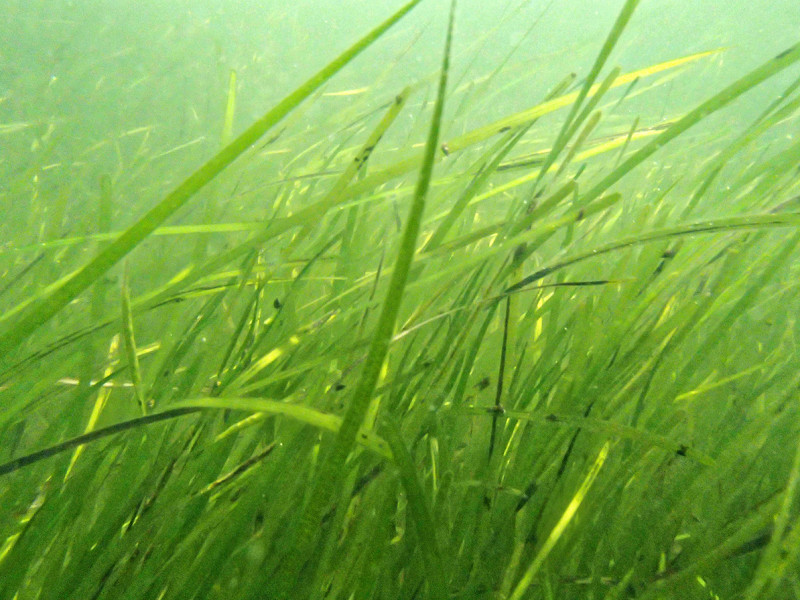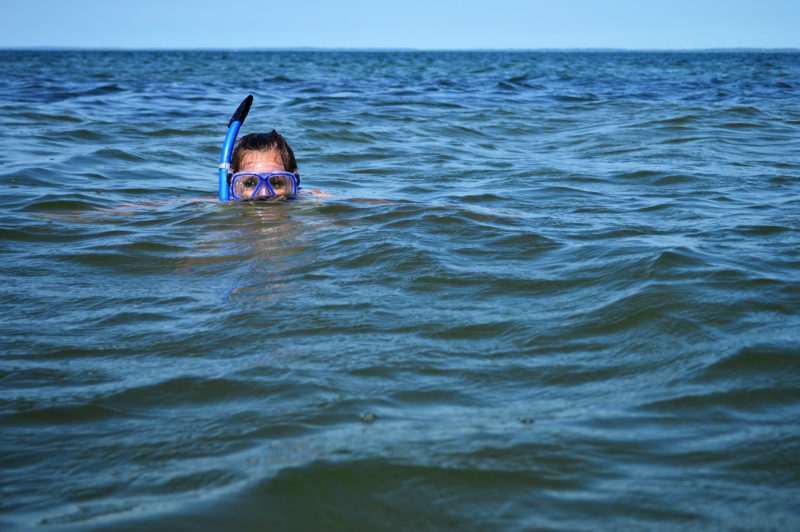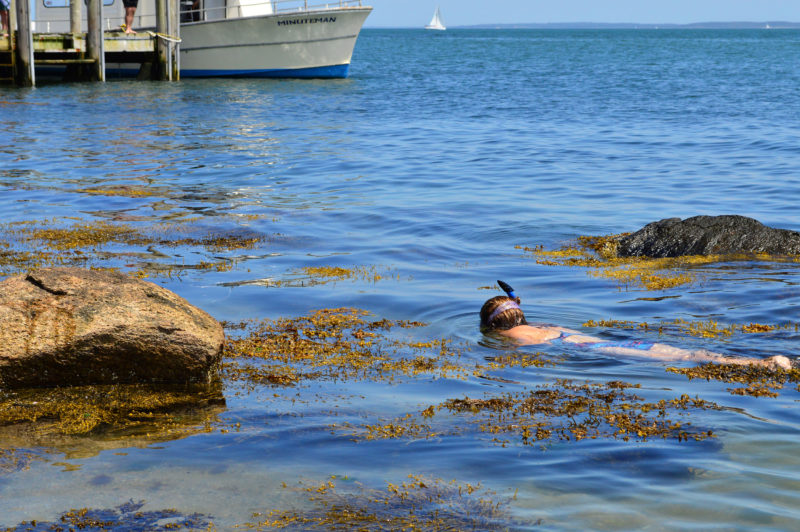How (and where) to go snorkeling in Buzzards Bay
As the temperatures climb, we’ll look for any way to spend a day at the beach and get in the water. If you’re looking for a new way to cool off from summer’s heat, snorkeling in Buzzards Bay provides just the ticket! Here’s everything you need to know to go snorkeling in Buzzards Bay this summer.
What will I see underwater when I go snorkeling in Buzzards Bay?

Look for eelgrass growing in clear, shallow waters in Buzzards Bay.
The fish in Buzzards Bay might not be as flashy as in places like Florida and the Caribbean. But there are still plenty of interesting critters to spot here – and it’s a whole lot closer to home! When you go snorkeling in Buzzards Bay, take a peek for some of these plants and animals:
- Eelgrass: Snorkeling gives you a great opportunity to get an up-close look at eelgrass, one of the Bay’s most important habitats. With its long, green blades swaying gracefully just below the water’s surface, eelgrass provides shelter for young fish, crabs, and bay scallops.
- Fish: As you’re snorkeling, look for the silver flash of small fish darting between blades of eelgrass. Two common species you might see among the eelgrass are mummichogs and silversides.
- Crabs: Snorkelers have the chance of seeing everything from hermit crabs to young swimming blue crabs. Watch for spider crabs, which are known to camouflage themselves with bits of seaweed. Lucky snorkelers may also come across a horseshoe crab in shallow areas with sandy or muddy bottoms.
- Bay Scallops: Bay scallops rely on eelgrass beds as they grow, so keep a careful eye out for them among the meadows. If you’re lucky enough to see a bay scallop, admire their 40 brilliant blue eyes – and watch in wonder as they clap their shells together to “swim” through the water!
- Whelks: Whelks are large, predatory snails that prowl the Bay’s sandy bottom looking for their prey, which includes clams and oysters. You might also see their egg cases: strings of connected pouches known as mermaid’s necklaces.
- Grass Shrimp: Tiny, transparent grass shrimp are common in Buzzards Bay’s shallows. You’re bound to see them crawling along the sandy bottom and swimming among eelgrass beds.
- Starfish: Technically, starfish are known as sea stars. Whatever you call them, you might find one if you’re snorkeling around rocks, jetties, or pilings.
- Barnacles: Have you ever seen a live barnacle underwater? You’ll be mesmerized when they open up and release their feathery appendages to gracefully sweep through the water for food! Look for barnacles attached to rocks and pilings.
What else might you find when you go snorkeling? You never know until you get out there and try it – so go get your gear and start exploring your Bay!
What do I need to go snorkeling?

Snorkeling is fun and easy for anyone to try with some simple, inexpensive equipment.
Snorkeling is easy and inexpensive for beginners. Anyone can do it! All you need to get started is a mask and a snorkel, which you can purchase online or at any local sporting equipment store. You may also want to get a pair of fins, but that isn’t necessary to give snorkeling a try.
When picking out a mask, look for one that fits your face properly. To test this, hold the mask to your face and inhale through your nose. If the mask seals and stays on your face, it’s a fit! You also want to make sure the strap is secure across the widest part of your head.
Once you’ve got your gear, it’s a good idea to practice breathing while wearing your mask and snorkel before you get in the water. You don’t need to bite down on the mouthpiece to keep it secure – just rest your teeth on the plastic and breathe in and out normally.
When you’re ready to get in the water, start by simply floating face-down to get comfortable. Then start kicking your feet up and down to gently paddle across the water’s surface. Remember to explore at your own pace and stay relaxed. If you start to have trouble breathing through the snorkel, you can always lift your face out of the water and take out your mouthpiece for a few breaths.
As you explore, you might accidentally get some water in your snorkel. Don’t panic – you can clear the airway by exhaling forcefully while your face is still submerged and the top of the snorkel is in the air. A couple of these blasts will clear your snorkel of any water. Once you become comfortable doing this, you can even dive underwater and clear the airway when you emerge.
Another tip to follow when you’re snorkeling: Keep an eye on your surroundings. You can lose track of how far you’ve swam from shore, or any obstacles around you, when your face is in the water. For safety, lift your head to check your surroundings every few minutes. Or snorkel with a friend and take turns exploring.
Where can I go snorkeling in Buzzards Bay?

In calm, shallow waters, try snorkeling around rocks and jetties, where lots of underwater species live.
Snorkeling is a fun activity that you and your kids can do at most beaches around Buzzards Bay. Look for clear, shallow waters with lots of eelgrass, where fish, crabs, and other underwater species tend to gather. In calm waters, you can snorkel near rocks and jetties to search for interesting critters just below the surface.
To get you started, here are 11 good snorkeling spots around Buzzards Bay. Wherever you go, make sure you follow all beach rules for snorkeling in marked swimming areas. If you’re not sure if snorkeling is allowed at your beach, just ask a lifeguard.
- Gooseberry Island (Westport): Head to the beach on the eastern side of the island. This sheltered cove makes for an interesting snorkeling spot.
- Demarest Lloyd State Park (Dartmouth): Demarest Lloyd is known for its extensive sandbars, which sit right where the Slocums River empties into Buzzards Bay. Search these warm, shallow waters for tiny fish and shellfish.
- Fort Phoenix State Reservation (Fairhaven): Search around the rocks and eelgrass along the shore for the critters that live here in outer New Bedford Harbor.
- West Island Town Beach (Fairhaven): Eelgrass beds flourish in the open waters off West Island. Lots of small fish and crabs live here, making the beach an ideal spot for snorkeling.
- Silvershell Beach (Marion): The calm waters of Silvershell Beach in Marion make it a good place to hone your snorkeling skills. Swim along the beach’s rock jetties to see what creatures hide there.
- Shell Point Beach (Wareham): Explore the protected waters of Onset Bay and Shell Point Bay, where you can search for crabs and other shellfish in the shallows.
- Wood Neck Beach & Little Sippewissett Marsh (Falmouth): With its lush natural setting, Wood Neck Beach is a great snorkeling spot for Falmouth residents. Check out the tidal creek between the beach and Little Sippewissett Marsh, where swimmers gather to snorkel, swim, and ride the current.
- The Knob (Falmouth): Quissett Harbor has some of the clearest waters in Buzzards Bay, which makes it fun to explore with a snorkel. Check out Little Sandy Beach, an ideal spot for kids to swim and search for starfish, crabs, and other critters.
- Stony Beach (Falmouth): Stony Beach is a peaceful beach in Woods Hole, tucked away from the village crowds. Beginners can explore the rock jetties and test their snorkeling skills.
- Penikese Island (Gosnold): The clean waters surrounding Penikese Island are rich with eelgrass and underwater life, which makes them perfect for snorkeling. The only trick is getting there! Although there’s no public boat ramp on Penikese Island, you can anchor offshore and swim or paddle around the shore.
- Church’s Beach (Gosnold): Bring a snorkel and mask the next time you escape to Cuttyhunk, and head to Church’s Beach along the island’s northwest shore. Look for interesting marine creatures here, like pipefish – a relative of the seahorse!